The Mindset of Kristian Høgenhaug
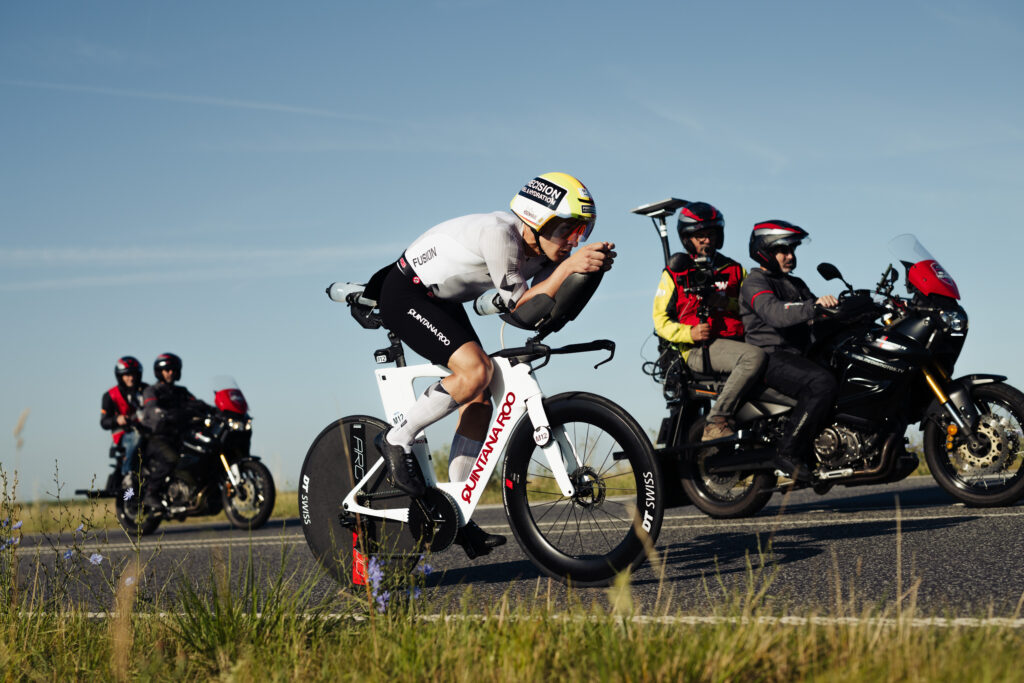
All photos courtesy of Kristian Høgenhaug/ IRONMAN
“I don’t think anyone mentioned me before the race, but I knew what I had been capable of in training with the fitness I had,” said Kristian Høgenhaug. “I knew I was aiming to fight for the win and get on the podium, but it also wasn’t something to speak out about.”
Off the back of his incredible performance at IRONMAN Frankfurt against a world championship-level field, Høgenhaug is worthy of some attention. His second place was a statement, one that he would never say out loud, but one that spoke volumes.
“In Danish culture, you don’t speak highly about yourself–it’s so ingrained in me–but it’s also easy to say you’re going to win and hard to do,” said Høgenhaug
A 48:05 standout swim put Høgenhaug at the back of the lead pack, but it was on the bike where he truly showed his form. Putting in a solo attack, Høgenhaug rode himself to the front within the first 40 km and stayed there, averaging 319 watts to build an incredible 7:50 lead. To add a touch of class to his phenomenal ride, he looked great coming off the bike into T2 with smooth, confident steps. The Høgenhaug show continued for another 34 km, even after serving a controversial one minute penalty for outside assistance, but Kristian Blummenfelt made the catch and ran on to victory. Høgenhaug finished the marathon in 2:42 to secure second place, and the best performance of his career.
“I have come second before in Frankfurt, but because of the field and how everything played out, I’m very happy, to be honest,” he said.
The Dane admits the reaction to his performance is “not like anything before” and that’s because it isn’t like anything he has done before. The 2025 season marked a lot of changes for Høgenhaug, from leaving the BMC team and changing his bike to his impending fatherhood and training less for more watts.
Big Changes for 2025
First off, it’s not like Høgenhaug has been a slouch until this point. He just won the Challenge Championships and came into the season ranked 30th in the PTO world rankings with a ninth place finish in Kona last year, where he posted the fifth fastest bike split. He’s been second and third in Frankfurt over the years, with wins in both full-distance and half-distance races throughout his career.
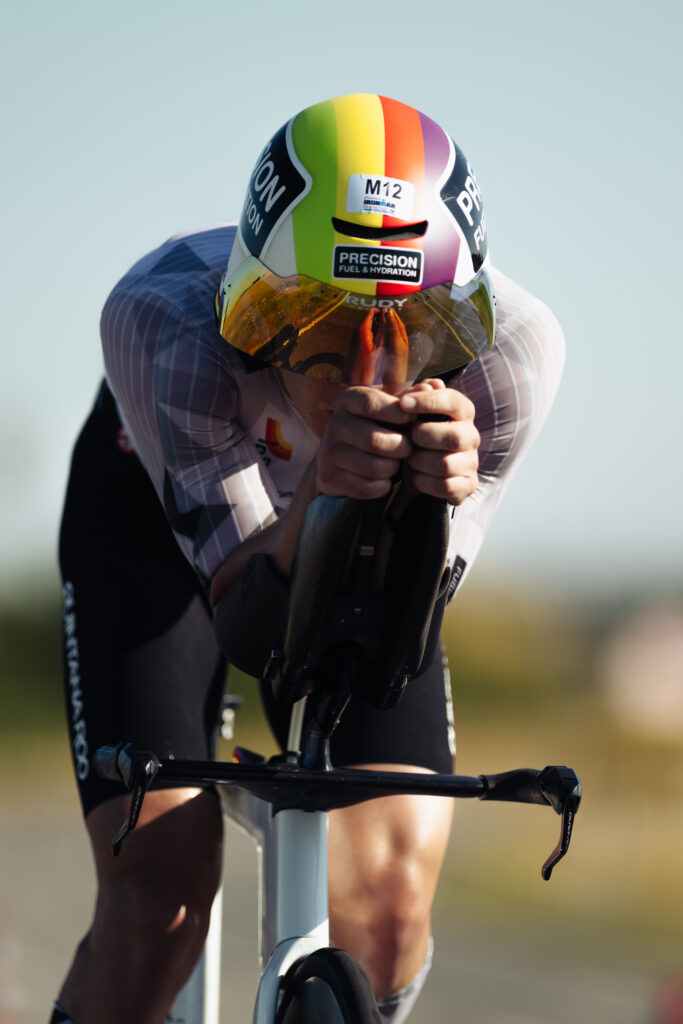
Høgenhaug leading on the bike at Ironman Frankfurt
At the end of last season, his best to date, Høgenhaug had a string of “almosts” and felt it was time to make some changes. The biggest was leaving the BMC team.
“I loved the BMC team because a lot of things were taken care of, but I felt I was at the point in my career that if I needed to step out,” he said. “It was a good time.”
Høgenhaug took it as an opportunity to move his career forward, choosing to work with sponsors where he felt he had a voice, but the change didn’t come without fear.
“I could take charge of every partnership to find the fastest possible set up…but it was terrifying,” he said. “I went to the velodrome with the Quintana Roo and I had just signed the deal and it really hit me: potentially the base line would be much slower.”
Turns out, he had nothing to worry about. With the same base line, Høgenhaug went on to find an even faster set up.
“I changed quite a lot last year,” he said. “I tried to be as long as possible [like Magnus Ditlev], but that was slower.”
“Everyone was copying Magnus, he was the first [to look long],” Høgenhaug continued. “Everyone knew it was something he tested tons of times and people copied his position. I hadn’t been in the velodrome, so I just went with everyone else, thinking more is better, but it wasn’t a position for me.”
Høgenhaug talks about body morphology, how his shorter arms and legs and longer torso suit a different set up, and how the best position for everyone is truly personal. He explains that he went from 170 mm to 165mm cranks and how he is more streamlined at the front, which made him more comfortable in the saddle and extensions.
“I came to realize my fastest position is so different from Magnus,” he said.
Turns out, it’s faster too: 6:55 faster than Ditlev in Frankfurt.
Less is Best
Still, you need the engine to run a bike that fast and that’s the other thing Høgenhaug changed this year. With the help of his longtime coach, they’ve “added another layer of fitness,” and he isn’t afraid to say he’s actually training less.
In the past, Høgenhaug felt pressure to keep a high cycling volume. Even though the extra hours were all in zone one, they added too much fatigue. Opting for more quality rather than volume, with total bike time being approximately 10 to 13 hours, Høgenhaug saw a marked increase in his performance.
His weekly menu includes double indoor bike sessions (he prefers ERG mode), with threshold intensity. Sessions in the morning are usually longer efforts with a total time of 40 to 45 minutes spent under load. In the afternoon, it’s shorter efforts at a higher power, such as 3 to 5 minutes at 400 watts. Both sessions start with a quick 10 to 15 minute warm up and a short 5 minute cool down for a total of 90 minutes, all while keeping an eye on his lactate to make sure he doesn’t overdo it.
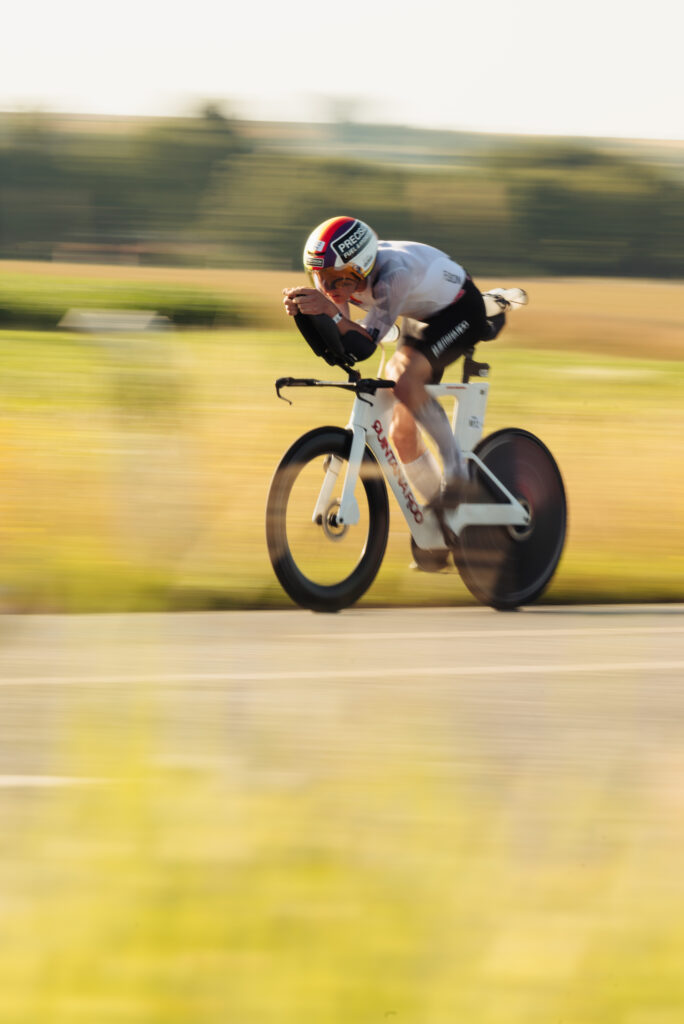
Høgenhaug, Ironman Frankfurt 2025.
Overtraining and Overthinking
Agreeing to change their approach to training came from Høgenhaug’s history of being overtrained. Not only did overtraining lead to performance deficits, but he also experienced sleep disturbance, lack of sex drive, erectile dysfunction, and, most significantly, a stress fracture in his lower back that ended his season after the 2023 world championships. It was the icing on the cake after two lack-lustre seasons–and he felt he wasn’t the only one who noticed.
“I had so many worries,” he said. “On BMC it was always a one year contract. I was always calm for the first three months and then for six months I worried if I was going to do triathlon the next year. It’s not a mentally good place to be in.”
The pressure he was putting on himself extended far beyond renewing his contract to the point where he truly thought he was facing a career change.
“I thought when I started the season last year, with two not so good years and the stress fracture, I felt like I had to perform in order to stay in the sport,” he said. “It felt like a make or break year and it was hard to deal with.”
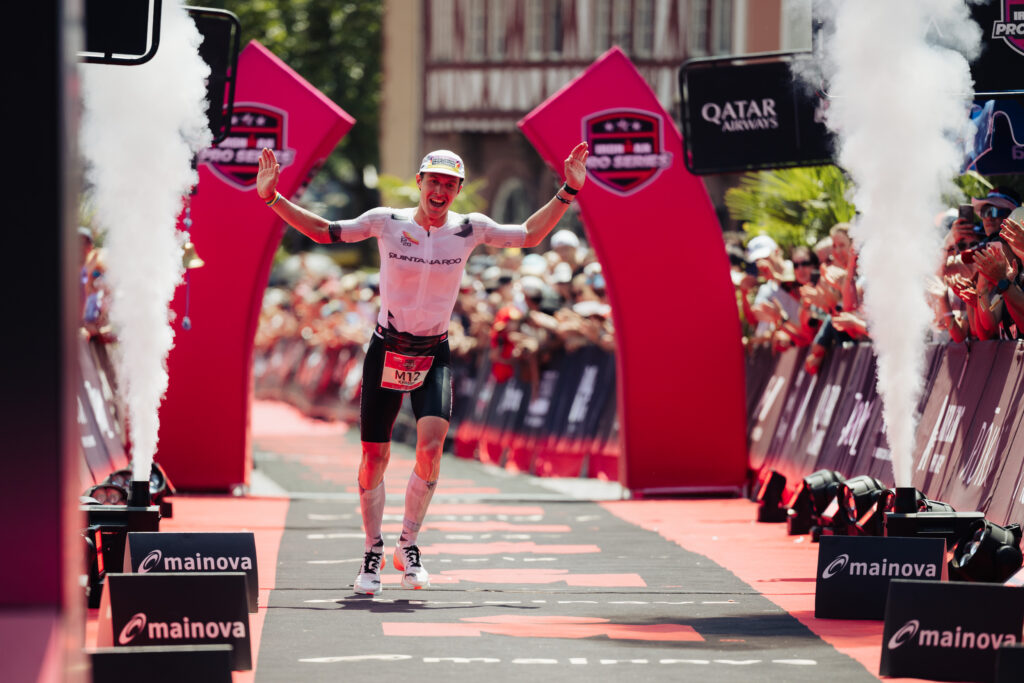
Value Added
That amount of pressure led him to seek the help of a sport psychologist.
“The sport psychologist told me you can’t expect not to be nervous or not to have fear,” he said. “In daily life and definitely in racing, you’re the bus driver and you pick up different people along the way. They will tell you bad things, like find a different job, but you just tell them ‘welcome, but have a seat in the back.’ You don’t have control over them but eventually they get off the bus.”
The “bus driver” mindset helped Høgenhaug shift his fearful thinking and lift the weight of performance pressure. The two also worked on creating a set of values, for both daily life and racing, to anchor decision making.
“For Frankfurt, my values were: be brave, be aggressive, and be patient,” he said. “Some might be counter to each other, but staying patient was trusting the plan, that if I were in the front coming off the bike, to be patient and stay on my pace for the run so I could have a chance to win. Being brave and aggressive was about impacting the race, willing to take a chance. I had hoped to attack with Magnus, but I had to go on my own, which was a chance and it was a brave move. Having the values, it felt more calm. I knew how I would act in situations.”
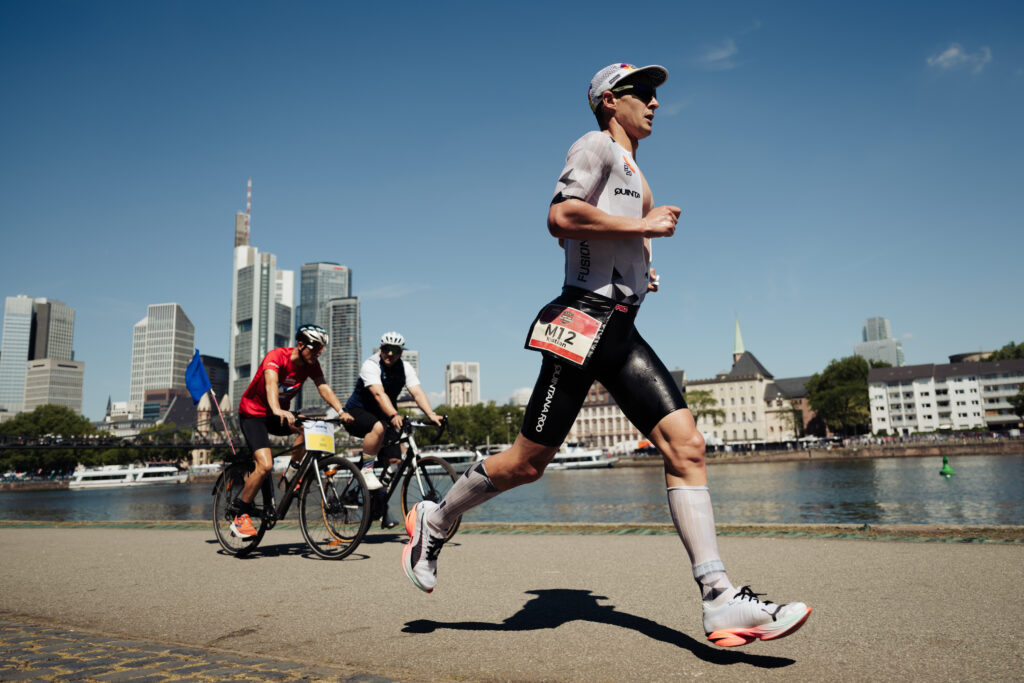
Høgenhaug leading the marathon at Ironman Frankfurt, 2025.
New Level, New Pressure
Høgenhaug doesn’t deny there is still pressure to perform, especially after Frankfurt, but it’s his relationship to that pressure–his mindset–that has changed.
“Emotionally there is internal pressure,” he said. “There are certain goals I want to achieve. They have changed over the years. My coach and I made a five year plan in 2019 where we thought the ultimate goal, physical potential, absolute max, was a top ten in Hawaii. I was ninth last year, five years later. The next five year plan is a podium at world championships.”
“Since Frankfurt, the expectations of myself have risen,” he continued. “Racing Swansea next, I can already feel that I have to perform now, but my coach is telling me to put everything into perspective, that I don’t have to perform every time if there is a good reason for it. The season is so long, you need to point out the races you want to do well in and, in between, don’t worry about it. That can prevent burnout because you don’t feel like you have to perform every time. That kind of pressure can also take the fun out of it. I love racing, but if I don’t perform, it takes all the fun and enjoyment out of it.”
What keeps his mindset in check is staying present: “This is what’s happening right now and I’m doing the best I can. You can use it all the time. I keep going away from it but I get a message from my coach and I go back to it.”
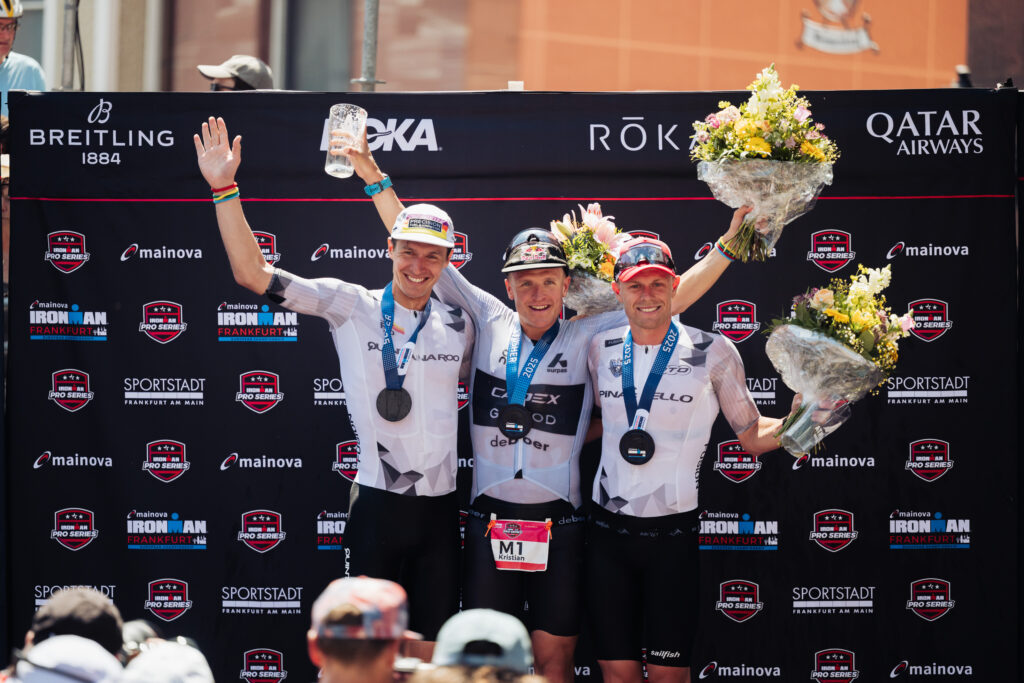
IRONMAN Frankfurt 2025 podium. From left to right: Kristian Høgenhaug, Kristian Blummenfelt, Casper Stornes.
Grounded
From the podium in Frankfurt, Høgenhaug can look back and see how he used his lowest point as an opportunity for physical and mental growth.
“A lot of good things happened after the stress fracture,” he nods and smiles.
He recounts all the professional changes he made and also that he chose to stay home. Staying home in Denmark gave him more time and space for his social relationships, including his newest relationship: his partner is pregnant and they are expecting a little girl in the autumn. Høgenhaug’s new venture into fatherhood has already impacted his performance.
“I believe I’ve already changed quite a bit,” he said. “I felt this year I try to do better, more focused on training and getting the most out of training, trying to be better at sleeping–do everything a bit better. I see it from a different perspective: what would she think of me? I want to be a great role model.”
With the due date only a couple weeks before the Ironman World Championships in Nice, it’s a good thing Høgenhaug is so calm these days.
“I’m more relaxed this year…Remember to enjoy all the things you get to enjoy,” he said. “If it doesn’t work out, it’s not the end of the world and it can take the joy out. It will work out either way.”




Start the discussion at forum.slowtwitch.com